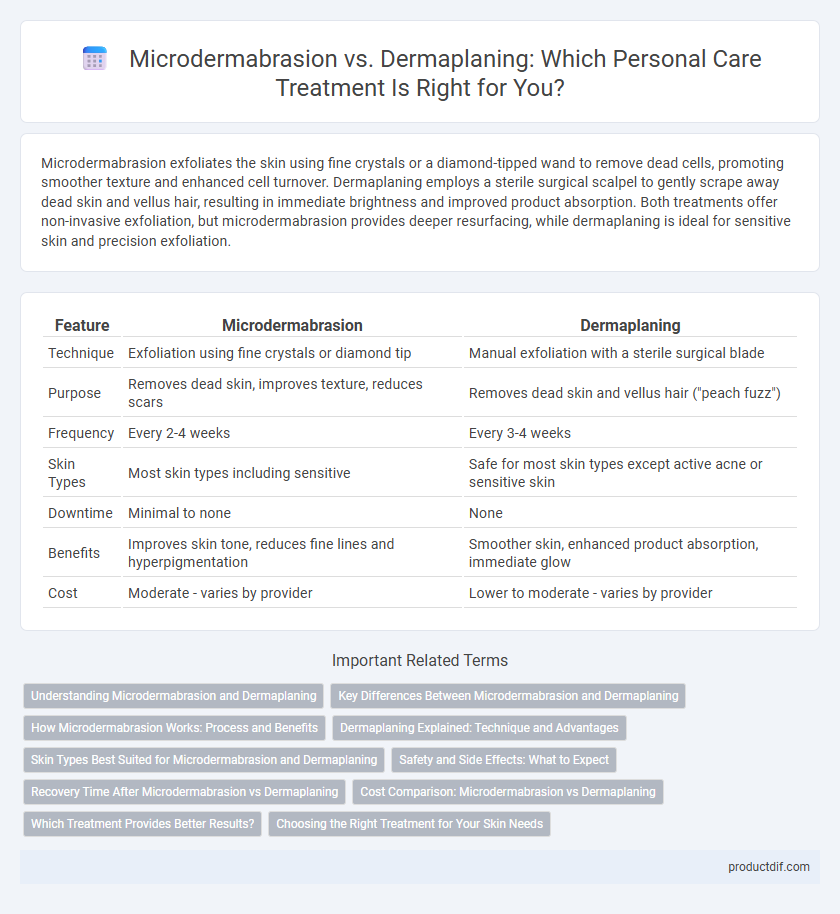Microdermabrasion exfoliates the skin using fine crystals or a diamond-tipped wand to remove dead cells, promoting smoother texture and enhanced cell turnover. Dermaplaning employs a sterile surgical scalpel to gently scrape away dead skin and vellus hair, resulting in immediate brightness and improved product absorption. Both treatments offer non-invasive exfoliation, but microdermabrasion provides deeper resurfacing, while dermaplaning is ideal for sensitive skin and precision exfoliation.
Table of Comparison
| Feature | Microdermabrasion | Dermaplaning |
|---|---|---|
| Technique | Exfoliation using fine crystals or diamond tip | Manual exfoliation with a sterile surgical blade |
| Purpose | Removes dead skin, improves texture, reduces scars | Removes dead skin and vellus hair ("peach fuzz") |
| Frequency | Every 2-4 weeks | Every 3-4 weeks |
| Skin Types | Most skin types including sensitive | Safe for most skin types except active acne or sensitive skin |
| Downtime | Minimal to none | None |
| Benefits | Improves skin tone, reduces fine lines and hyperpigmentation | Smoother skin, enhanced product absorption, immediate glow |
| Cost | Moderate - varies by provider | Lower to moderate - varies by provider |
Understanding Microdermabrasion and Dermaplaning
Microdermabrasion involves exfoliating the skin using fine crystals or a diamond-tipped wand to remove dead skin cells and stimulate collagen production. Dermaplaning uses a sterile surgical blade to gently shave the outer layer of dead skin and vellus hair, promoting smoother texture and enhanced product absorption. Both treatments improve skin appearance but differ in technique, intensity, and suitability for various skin types.
Key Differences Between Microdermabrasion and Dermaplaning
Microdermabrasion uses a diamond-tipped or crystal exfoliating device to remove dead skin cells and stimulate collagen production, while dermaplaning involves a sterile surgical scalpel to gently shave the skin's surface and vellus hair. Microdermabrasion typically penetrates deeper, addressing issues like fine lines, light scarring, and hyperpigmentation, whereas dermaplaning primarily targets surface exfoliation and peach fuzz removal. Recovery for microdermabrasion may involve mild redness and sensitivity, while dermaplaning usually allows for immediate radiant skin with minimal downtime.
How Microdermabrasion Works: Process and Benefits
Microdermabrasion works by exfoliating the outermost layer of dead skin cells using a specialized device that sprays fine crystals or employs a diamond-tipped wand to abrade the skin gently. This process stimulates collagen production, improves skin texture, reduces fine lines, and minimizes pores, making it effective for treating acne scars, hyperpigmentation, and uneven skin tone. The non-invasive procedure promotes cell renewal and enhances the absorption of topical skincare products, resulting in a smoother, more radiant complexion.
Dermaplaning Explained: Technique and Advantages
Dermaplaning involves using a sterile surgical scalpel to gently exfoliate the skin by removing dead cells and fine vellus hair, resulting in a smoother and brighter complexion. This technique enhances skincare product absorption, reduces the appearance of acne scars and fine lines, and offers an immediate, noticeable glow without downtime. Suitable for most skin types, dermaplaning is a safe and effective method for achieving radiant, exfoliated skin compared to microdermabrasion, which uses abrasive materials and may cause sensitivity.
Skin Types Best Suited for Microdermabrasion and Dermaplaning
Microdermabrasion suits oily and acne-prone skin by effectively removing dead skin cells and unclogging pores through exfoliation with fine crystals or diamond tips. Dermaplaning is ideal for sensitive, dry, or mature skin as it gently exfoliates surface dead skin and removes fine vellus hair without irritation. Both treatments improve skin texture but are chosen based on individual skin tolerance and concerns.
Safety and Side Effects: What to Expect
Microdermabrasion involves exfoliating the skin using fine crystals, which may cause mild redness and sensitivity but generally has a low risk of adverse effects when performed correctly. Dermaplaning uses a sterile surgical blade to gently scrape off dead skin cells and peach fuzz, with minimal irritation and a rare chance of minor cuts or infections. Both treatments require proper technique and aftercare to minimize risks, making consultation with a licensed skincare professional essential for safe outcomes.
Recovery Time After Microdermabrasion vs Dermaplaning
Recovery time after microdermabrasion typically ranges from 24 to 48 hours, characterized by mild redness and sensitivity as the skin exfoliates and regenerates. Dermaplaning recovery is usually quicker, often within 24 hours, with minimal redness or irritation due to the superficial removal of dead skin and peach fuzz. Both treatments promote smoother skin texture, but dermaplaning offers faster downtime, making it suitable for those seeking rapid recovery.
Cost Comparison: Microdermabrasion vs Dermaplaning
Microdermabrasion typically costs between $75 and $200 per session, requiring multiple treatments for optimal results, while dermaplaning sessions range from $50 to $150, often providing immediate visible improvement with fewer visits. Although microdermabrasion may appear pricier upfront, its exfoliation intensity and skin renewal benefits can justify the investment over time. Dermaplaning presents a budget-friendly option with quicker sessions, appealing to those seeking cost-effective, immediate skin smoothing solutions.
Which Treatment Provides Better Results?
Microdermabrasion uses fine crystals to exfoliate the skin gently, effectively reducing acne scars, hyperpigmentation, and fine lines by promoting collagen production. Dermaplaning involves a sterile blade to remove dead skin cells and peach fuzz, resulting in smoother skin texture and enhanced product absorption. For deeper exfoliation and improved skin tone, microdermabrasion often delivers more noticeable long-term results, while dermaplaning is ideal for immediate smoothness and makeup application.
Choosing the Right Treatment for Your Skin Needs
Microdermabrasion exfoliates the skin using fine crystals to remove dead cells, ideal for reducing acne scars and improving skin texture, while dermaplaning employs a sterile blade to carefully shave off dead skin and vellus hair, enhancing product absorption and providing immediate smoothness. Sensitive or acne-prone skin may benefit more from dermaplaning due to its gentle approach, whereas microdermabrasion suits those seeking deeper exfoliation and stimulation of collagen production. Assessing skin type, sensitivity, and desired results ensures selecting the most effective treatment for personalized skin care.
microdermabrasion vs dermaplaning Infographic

 productdif.com
productdif.com